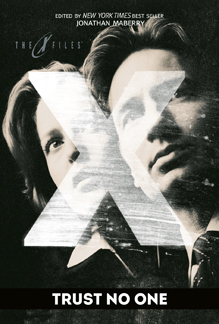“The X-Files” returned to comics in 2013, it will return to the small-screen for six episodes starting on Jan. 24, and last year it returned to bookshelves with “Trust No One,” a collection of short stories published by IDW, which also produces the comics. With the exception of the “I Want to Believe” movie novelization in 2008, it marks the first “X-Files” book since a six-book run in during the show’s heyday in 1990s.
These 15 stories are hit and miss; I’d recommend this collection for “X-Files” die-hards but not casual fans. As is often the case with books published by companies that don’t regularly publish books, it has a higher-than-usual percentage of typos and line-editing errors, although it’s not so bad as to render it unreadable. Many of the stories could’ve benefited from one more pass from a copy editor, and some of them needed a lot more work. Still, there are some valuable additions to the lore and some just-plain-fun monster yarns; some require the short-story format while others feel like rough outlines for a TV episode and actually suffer a bit in this format.
Here are the 10 standout stories:
1. “Dusk” by Paul Crilley (set in 2015 in Castle Bluff, N.H.) – Crilley riffs on the “Twilight” craze with the thinly veiled stand-in of the “Dusk” novels, written by a recluse who hates his own books. Rumors that the “Dusk” vampire is real draw several teen girls to the area, many of whom go missing. It’s a fun commentary on shallow pop fiction.
2. “Back in El Paso, My Life Will Be Worthless” by Keith R.A. DeCandido (1994, El Paso, Texas) – DeCandido, who also showed great insight into the “Firefly” verse with his “Serenity” novelization, introduces the evocative Special Agent Jack Colt, who resists help from Mulder and Scully in investigating a serial-killing spree that continues after several suspects are locked up for the crimes.
3. “Paranormal Quest” by Ray Garton (1997, Bella Vista, Calif.) – Garton riffs on haunted-house reality shows by throwing in a twist where a person in the house, rather than the building itself, might be haunted.
4. “Statues” by Kevin J. Anderson (1995, Furnace Creek, Calif.) – Anderson, who also penned three 1990s “X-Files” novels, is great at painting an evocative picture, though not quite as good at surprising a reader. But the concept of people turning to stone would’ve made a great “X-Files” episode.
5. “The House on Hickory Hill” by Max Allan Collins (1997, Banewich, Mass.) – Similar to Garton’s story, Collins – who also wrote the “I Want to Believe” movie novelization, delves into the backstory of a haunted house.
6. “Oversight” by Aaron Rosenberg (1994, Washington, D.C.) – Early in the show’s run, Skinner’s motives were presented as a mystery; later, it became clear he was on the side of Mulder and Scully. Here, he battles an FBI auditor to keep the X-Files open while also investigating an X-File on his own.

7. “The Beast of Little Hill” by Peter Clines (1995, Little Hill, Mo.) – It starts as a fun story of M&S investigating two rival backwater museums showing alien remains encased in ice. Similar to that “Scooby Doo” episode with the Wooly Mammoth, the aliens might not be dead after all.
8. “Non Gratum Anus Rodentum” by Brian Keene (1994, Washington, D.C.) – Like “Oversight,” we get more insight into Skinner, as it turned out he experienced an X-File back in his Vietnam War days, although he didn’t totally realize it at the time. A quarter century later, the case resurfaces.
9. “Loving the Alien” by Stefan Petrucha (1997, South Carolina) – In a twist on the format, Petrucha – the primary writer of the 1990s Topps “X-Files” comics – tells the story in present tense and from Scully’s perspective. Similar to many Season 8 and 9 episodes, Mulder is central to the story without being in it much.
10. “Clair de Lune” by David Benton and W.D. Gagliani (1994, south of Ottawa) – The authors do a nice job illustrating the snowstorm our agents are stuck in, then do a twist on an old-fashioned werewolf story.

